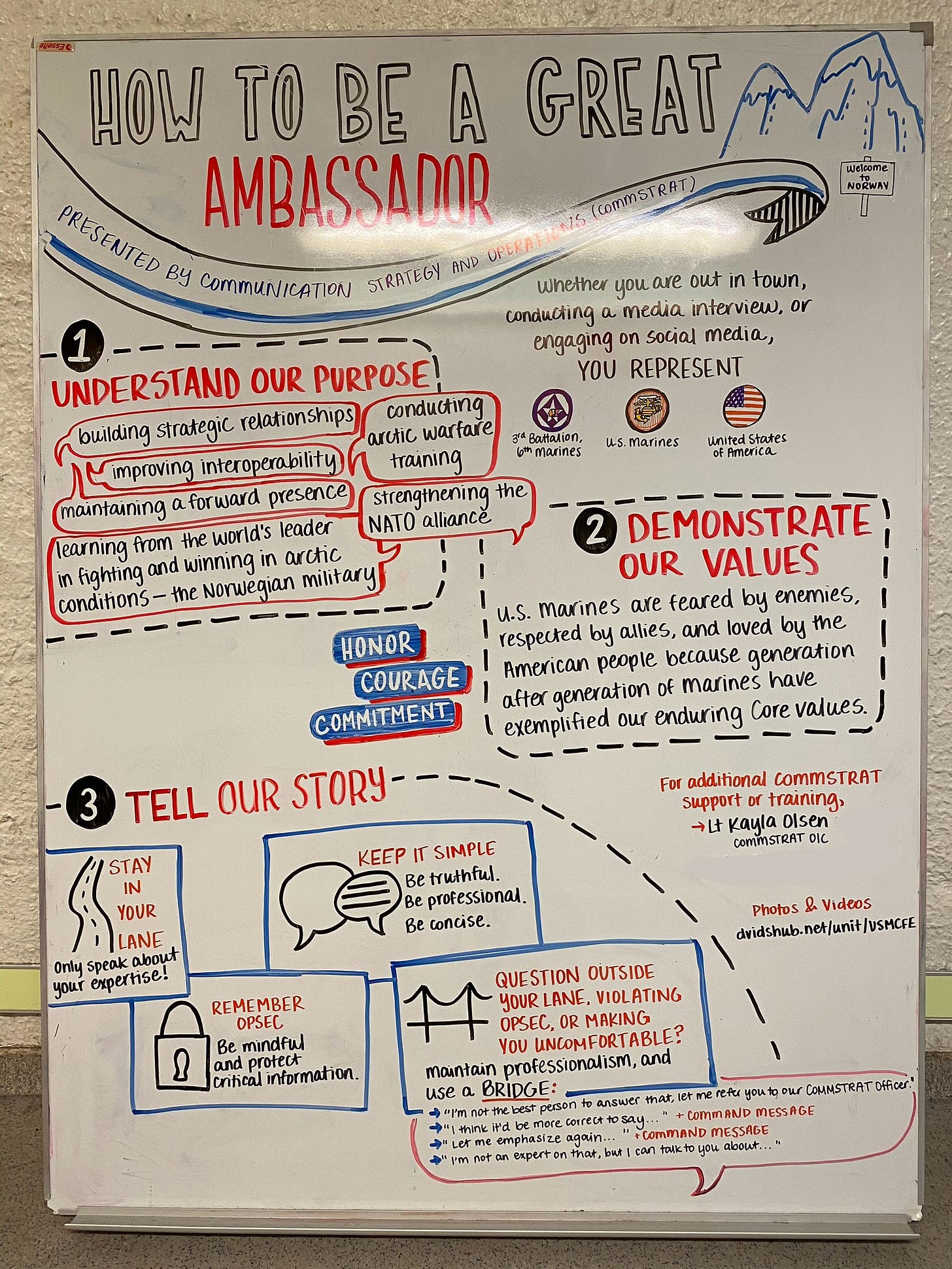Whiteboard: How to Be a Great Ambassador
A Framework for Building Relationships, Upholding Values, and Telling Your Story
During my time attached to 3rd Battalion, 6th Marines for Marine Rotational Force Europe (MRF-E) in Norway, I had the opportunity to contribute to our communication strategy. One of the key pieces I designed was the whiteboard guide titled “How to Be a Great Ambassador.” Originally crafted for our Marines on this rotational deployment, I’ve since realized that the principles outlined in this guide are universally applicable. Whether you’re part of a military unit, a corporate team, or any organization that interacts with external stakeholders, these core ideas help foster positive relationships, reinforce values, and tell your story effectively.
1. Understanding the Purpose:
The first section of the guide focuses on “Understanding Our Purpose.” In Norway, this meant improving interoperability with NATO allies, particularly the Norwegian military, while conducting Arctic warfare training. The mission was clear, but the framework can apply to any organization—building strategic relationships, maintaining a forward presence, and strengthening partnerships are fundamental goals for both military units and civilian organizations alike.
For any team, understanding its purpose and the broader mission is key. Whether you’re working with clients, partners, or other organizations, clarity of purpose ensures alignment and drives successful outcomes.
2. Demonstrating Our Values:
This section highlights the importance of core values like Honor, Courage, and Commitment. While these values are central to the Marine Corps, every organization has its own set of values that shape its culture. It’s crucial to demonstrate these values in every interaction, whether with partners, clients, or the public.
Just as Marines are constantly representing the United States and the Marine Corps, teams in any industry are always representing their brand, company, or organization. Embodying the organization’s values ensures consistency, trust, and a strong reputation.
3. Telling Our Story:
Effective communication is essential. In the guide, I emphasize the importance of staying in your lane, keeping things simple, and protecting sensitive information. These communication principles are just as critical in the corporate world as they are in the military. Whether it’s maintaining confidentiality with clients, ensuring professionalism in public communications, or telling your organization’s story in an authentic way, clear and truthful communication builds credibility.
Additionally, learning how to gracefully manage questions or conversations outside of one’s expertise applies across the board. The bridging techniques I outlined can be useful for anyone who needs to navigate complex conversations while maintaining professionalism and focus.
Final Thoughts:
While this whiteboard guide was created specifically for MRF-E in Norway, its framework is versatile and can benefit any team or organization. Being an ambassador isn’t limited to military operations—it’s about representing your group with integrity, fostering relationships, and ensuring your actions align with your organization’s values.
I hope this guide continues to inspire others who serve in ambassadorial roles, whether in the military or in other industries. The principles of understanding your mission, representing your values, and telling your story clearly are universal. If you’ve had similar experiences or insights on being an ambassador for your organization, I’d love to hear about them in the comments below!
For more content:






Hope the strengthening NATO alliance still holds true , I agree EU needs to do more , but Putin is a despot
This all rings very true for me.. As a Liaison Officer, my entire function is to help extremely disparate organizations tell their story to each other; my team is the conduit through which this happens, and relationships flourish from there. All of this has come down to a blend of your three points here, and it wasn't until I truly understood our purpose and began telling that story to others, that I began to achieve real impacts.